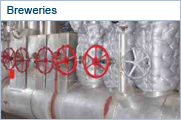Digitalising the measurements In the design offices at Thermatras®, the design drawings and measurements are translated into final digital drawings. Special design software from the clothing industry ensures that the measurements for the insulation blankets are very precise. Using nesting, the patterns required are placed as efficiently as possible on the fabric to be cut, so that wastage through off-cuts is kept to an absolute minimum and raw materials are used sparingly
Digital cutting In Thermatras’ modern studio, a digitally steered cutting machine (CNC) cuts the patterns on a 20 m2 cutting table with millimetre precision. The blankets made of glass fabric and/or synthetic fabric are thus given their final form.
Stitching Once cut, the pieces of fabric are stitched in our sewing studio according to pattern. In special cases, fastenings using Velcro or belts and buckles may be required. After the fabric has been stitched, the blankets go on to the next phase of the production process so that the seams are on the inside of the blankets.
Filling After stitching, the ‘empty’ Thermatras® insulation blankets are filled with mineral wool (Rockwool). This is done manually by skilled people so that the insulation is spread as evenly as possible. Insulation blankets are generally between 4 and 6 cm thick, although they may be thinner depending on their application. Different insulation material may be used in special cases.
Tufting Insulation blankets are tufted with stainless steel to prevent shifting of the mineral wool. The tufting is done using staples and a pneumatic tacker. The way the tufts are applied determines the final structure of the insulation blankets.
Hooks Finally, fastening stainless steel hooks are attached to the insulation blankets. When the blankets are installed, the fastening hooks are linked by stainless steel wire. This is done in a similar manner to that of laces in hiking boots.











